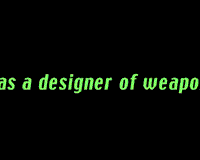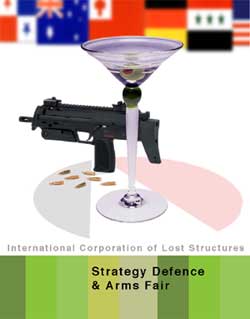|
|
|
 |
| Richard
Grayson |
Rationale
9:00
|
Leonardo Da Vinci's work as a designer of weapons, submarines, tanks, flying machines, military complexes and bridges for the Duke of Milan and Cesare Borgia has become an exemplar of a perceived 'ideal' relationship between artistic production and technology. A sort of use value and a commonality of research between the disciplines now seen as representative of an ideal lost relationship, the severing of which by the development of a technological culture is seen as somehow fatally disenfranchising arts practices. A desire to reinstate this relationship can be seen in the naming of the house journal of a boysy gee whizz modernist/utopian/teleological USA technology-based arts practices after the Italian artist.
Complex shifts have occurred in the relationships between the artist and the concept of warfare. In different historical developments of modernism there has been a willingness for artists to identify themselves with war, either metaphorically or actually, either in the service of the revolution or emergent nationalisms: Marinetti and the Futurists' noisy support for the Fascists is as good an example as Guernica. With the fragmentation of the modernist agenda and the atomization of Marxism, the western artists have increasingly aligned themselves with role of the conscience that is in opposition to war: a pacifist tradition that also developed in early modernity.
However, much of the vocabulary used to articulate the transformative agenda of the avant-garde and its inheritors is militaristic. The term Avant Garde is itself a military one, and refers to a small group that goes ahead of the main body of troops to survey and identify new territory that the mass of soldiers will later occupy. In art terms it contains the idea that the artist and their work may exemplify future cultural, social and spiritual changes. "It is we artists who will serve you as an avant-garde," says an artist to a social revolutionary in Saint Simon's book 'Opinions Litteraires', a socialist tract, written in 1825, "The power of the arts is the most immediate and most rapid: when we wish to spread new ideas among men we inscribe them on marble or canvas."
Such ideas find exemplary expression in current debates and manifestations of technology based art which still sees itself as operating on various advanced, transformative edges, using the teleological imperatives of technological innovation as a master narrative to inflect the rhetorics of the practice with the urgency of an otherwise discredited modernism. In this way it overtly expresses desires that other arenas of cultural practice find themselves increasingly unable to articulate
This combines with concurrent ideas of social engagement, and rhetorics of resistance - -Opposition, Guerilla, hacker-culture infowar and so forth. Now the default positioning of the techno-artist is modeled on that of terrorist:- a techno-Trotsky moving covertly against hegemonic oppressors: a Microsoft Mujuhadeen. But every Mujahideen needs a Kalashnikov
Technology based art uses technologies largely developed by the Military, which are dispersed into the social sphere and then subsumed back into the Industrial Military complex - the use of video games to train pilots, or the design of complex interactive shooter games to attract young men to the idea of enlisting in the armed forces. The existence of the military-industrial complex and the mechanisms of state control inevitably inflect all activities in the arena. This is amplified by a certain gender loading to the techno-fetishistic urge.
Young children - boys in particular - like making detailed drawings of guns/swords and castles and so forth. They then go on to computers.
Technology has the smell of adolescent, male, socks
We have just been involved in a war based on the existence of imaginary weapons and linguistic constructs; where Weapons of Mass Destruction as a phrase and concept is transmogrified from the Atomic bomb deployed only by the USA, to mustard and nerve gasses, the deployment of which, although deadly, fits neither previous understandings of Mass nor Destruction. It transpires that they may not exist as physical entities at all no matter how they are defined, but their existence has been generated through the validations of hi-tech Intelligence.


